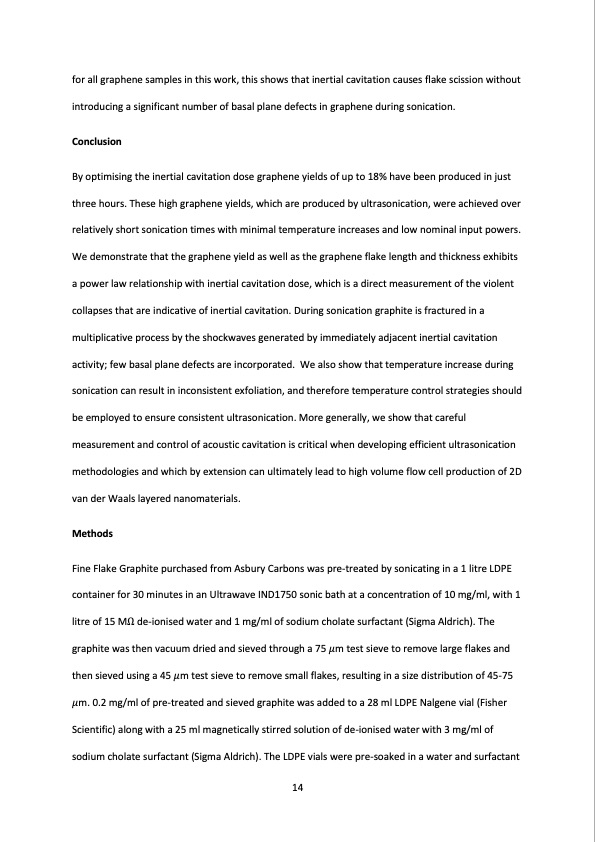
PDF Publication Title:
Text from PDF Page: 014
for all graphene samples in this work, this shows that inertial cavitation causes flake scission without introducing a significant number of basal plane defects in graphene during sonication. Conclusion By optimising the inertial cavitation dose graphene yields of up to 18% have been produced in just three hours. These high graphene yields, which are produced by ultrasonication, were achieved over relatively short sonication times with minimal temperature increases and low nominal input powers. We demonstrate that the graphene yield as well as the graphene flake length and thickness exhibits a power law relationship with inertial cavitation dose, which is a direct measurement of the violent collapses that are indicative of inertial cavitation. During sonication graphite is fractured in a multiplicative process by the shockwaves generated by immediately adjacent inertial cavitation activity; few basal plane defects are incorporated. We also show that temperature increase during sonication can result in inconsistent exfoliation, and therefore temperature control strategies should be employed to ensure consistent ultrasonication. More generally, we show that careful measurement and control of acoustic cavitation is critical when developing efficient ultrasonication methodologies and which by extension can ultimately lead to high volume flow cell production of 2D van der Waals layered nanomaterials. Methods Fine Flake Graphite purchased from Asbury Carbons was pre-treated by sonicating in a 1 litre LDPE container for 30 minutes in an Ultrawave IND1750 sonic bath at a concentration of 10 mg/ml, with 1 litre of 15 MΩ de-ionised water and 1 mg/ml of sodium cholate surfactant (Sigma Aldrich). The graphite was then vacuum dried and sieved through a 75 𝜇m test sieve to remove large flakes and then sieved using a 45 𝜇m test sieve to remove small flakes, resulting in a size distribution of 45-75 𝜇m. 0.2 mg/ml of pre-treated and sieved graphite was added to a 28 ml LDPE Nalgene vial (Fisher Scientific) along with a 25 ml magnetically stirred solution of de-ionised water with 3 mg/ml of sodium cholate surfactant (Sigma Aldrich). The LDPE vials were pre-soaked in a water and surfactant 14PDF Image | Cavitation Liquid Phase Exfoliation of Graphene

PDF Search Title:
Cavitation Liquid Phase Exfoliation of GrapheneOriginal File Name Searched:
1809-07630.pdfDIY PDF Search: Google It | Yahoo | Bing
Salgenx Redox Flow Battery Technology: Power up your energy storage game with Salgenx Salt Water Battery. With its advanced technology, the flow battery provides reliable, scalable, and sustainable energy storage for utility-scale projects. Upgrade to a Salgenx flow battery today and take control of your energy future.
| CONTACT TEL: 608-238-6001 Email: greg@infinityturbine.com | RSS | AMP |